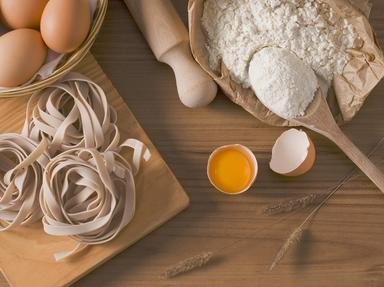Quiz Answer Key and Fun Facts
1. Chef asks you to chop some vegetables which will be used to make court bouillon. What does she want you to do with them?
2. Chef asks you to go to the pantry and fetch a cup of pickling salt. There is a large container marked "salt" from which the cellars on the tables are filled. What is the difference between pickling salt and table salt, if any?
3. A visiting chef from India says she is going to teach you how to make papadums (also spelled pappadam, pappadom, poppadam, popadam and several other ways). What are you about to learn to make?
4. Mrs. Dollop is the proprietress of The Tankard in Slaughter Lane in George Eliot's novel "Middlemarch." It might have been something about her physical appearance which led the author to give her this name. In culinary terms, what is a dollop?
5. A visiting chef from Mexico claims that chile relleno was invented in the city of Puebla, which happens to be his home town. If a Spanish-named dish includes the word "relleno" in it, what type of dish does one expect?
6. Rather than serve the soup in its individual bowls, Chef thinks it would add a bit of style to serve it at table from a tureen. What is a tureen?
7. Vinnie Ream (1847-1914) sculpted the statue of Abraham Lincoln in the U.S. Capitol Rotunda. A ream of paper is 500 sheets. To ream someone is to shout at, berate, reprimand, and scold them. What is meant by the verb "to ream" in kitchen terms?
8. Some fruits are named after places and some places are named after fruits. Which of the following fruits is neither named after a place nor has a place named after it?
9. Chef comes back from a Japanese cooking class raving about daikon. What is daikon?
10. One mounts the stairs, mounts a horse, mounts postage stamps in an album, mounts an attack, mounts a specimen on a slide for microscopic examination, and watches costs mount up. What does it mean "to mount" in a kitchen (keeping in mind that this is a family-oriented website)?
Source: Author
FatherSteve
This quiz was reviewed by FunTrivia editor
WesleyCrusher before going online.
Any errors found in FunTrivia content are routinely corrected through our feedback system.

